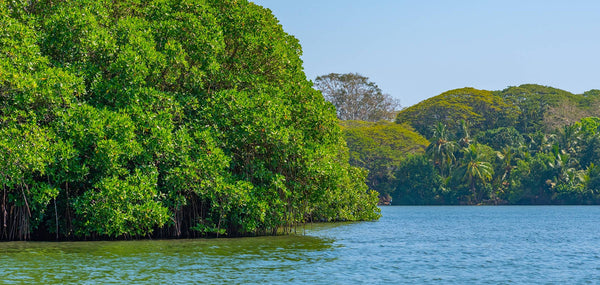
Get news, updates, & event Info delivered right to your inbox:
A globally recognized biodiversity hotspot, about 27% of Sri Lanka’s plants and 22% of its amphibians, birds, mammals, and reptiles are found nowhere else on earth. This incredible diversity is under threat, and many species have gone extinct — while others are threatened or endangered.
Much of Sri Lanka’s primary forest was lost under British colonial rule, when large sections of land were cleared for rubber, coffee, and tea plantations. The nation’s forests have been impacted by socio-political forces at home, too: 30 years of civil war led, at times, to one of the highest rates of primary forest deforestation in the world.
During the 1980s and early 1990s, much of the island’s rainforests were intentionally cleared by soldiers. At the same time, homes were destroyed and small-scale farmers were displaced, forcing them to deforest new areas to survive. Today, Conservation International estimates that just 1.5% of the nation’s historic forest cover remains — and just 8.6% of that is classified as primary forest (forest that has existed since ancient times or that has remained relatively undisturbed by human activity).
The civil war in Sri Lanka also had profound social implications: over the course of the conflict, more than 84,000 Tamils fled to neighboring India. Hundreds of thousands more sought refuge in Europe and North America, becoming one of the largest groups of asylum seekers in the western world. Many others were displaced within the country’s borders, too.

Our planting partner was one of those refugees: he spent 13 years living in the Indian state of Tamil Nadu. While there, he worked with Indian NGOs doing critical restoration work — and was inspired to apply his knowledge at home. Upon returning to Sri Lanka, he began assessing the needs of the people and the landscape. He then founded the NGO “Voluntary Organization for Vulnerable Community Development” (VOVCOD), building coalitions with local stakeholders from governmental and community organizations.
Here in this wild and beautiful land, fishing is a central facet of culture and livelihood for coastal communities. During the civil conflict, many lagoon areas were severely damaged, destroying mangrove trees and severely impacting these communities. As things settled, Northern Sri Lanka’s resource-rich coastal region became a lodestone of economic development. Today, its people are passionately determined to rebuild their lives and restore the land.
Reforestation in Sri Lanka
Through two projects since 2021, we have supported the restoration of four lagoons that underpin critical local fisheries. These projects engage local fisherfolk — who fish coastal lagoons early every morning — in a slightly different activity: collecting mangrove seeds as they float in with the tides. Mangroves provide spawning habitat for many aquatic species; therefore, seed collection is an act of survival.

Planting Mangrove Trees for Habitat Restoration and Livelihoods
This year, mangrove trees will be planted on government lands, which are maintained by the coastal conservation department. The mangrove seedlings, most of which were grown in our partner’s nursery, include the species Rhizophora, Avicennia marina, and Ceriops tagal. Many cottage industries in Sri Lanka, including mat mending and fishing material construction, depend on healthy mangroves. These industries are central to the livelihoods of coastal fisherwomen, helping them support their families and secure a higher standard of living.
Mangrove trees form critical habitat for fish, crustaceans, and other marine mammals. They provide nesting and breeding grounds for many bird species, demersal fish species, shrimp, and other wildlife. They also protect eggs, create shelter for brooding, and foster essential food sources for adult, larvae, juvenile, and fingerling fish.
In addition to supporting local livelihoods and forming critical biodiversity habitat, Mangroves provide a powerful buffer against erosion, typhoons, and tidal waves — and can help prevent much of the destruction associated with these natural disasters. All of these functions underscore the central role they play in maintaining healthy, vibrant ecosystems — and protecting the incredible diversity of life that Sri Lanka is known for.

Planting Native and Fruit Trees at Schools
Native and fruit trees are also being planted in 200 schools from the Vavuniya and Trincomalee districts, across 100 villages — and include teak, sandalwood, mahogany, coconut, mulberry, mango, guava, and jackfruit. These trees are being planted in coalition with educational directors, rural development societies, youth forums, and sports clubs.
Planting native trees in schools benefits students by providing shade and regulating temperatures. It also fosters learning opportunities about the importance of, and methods to, restore the environment.
Planting fruit trees provides nutrition and income, and will be particularly beneficial in rural villages that are still recovering from the economic impacts of the war. After planting, members of fisherman cooperatives and school societies will monitor and report on the growing trees, implementing remedial measures as needed.

Similarly, our 2021 project engaged fishing communities in the Mannar and Kilinochchi districts. This project exclusively planted mangrove trees for coastal restoration, and included Rhizophora, Avicennia marina, and Ceriops. Participants learned and applied knowledge about integrated management of coastal resources, mangrove planting and management, and the effects of coastal pollution.
Our Sri Lanka project is a story of unrelenting hope and courage in the face of profound challenges. It’s a powerful example of how the simple act of planting trees can change lives for the better.
